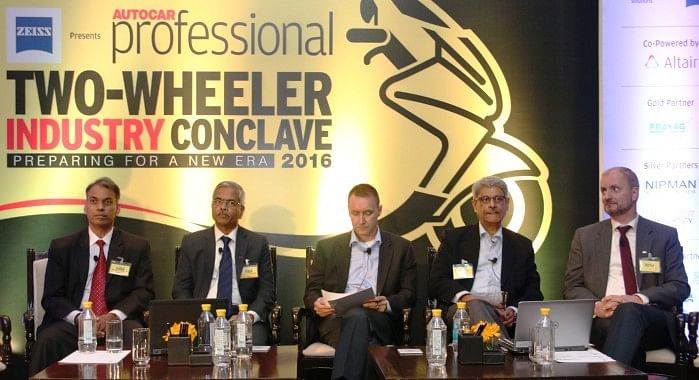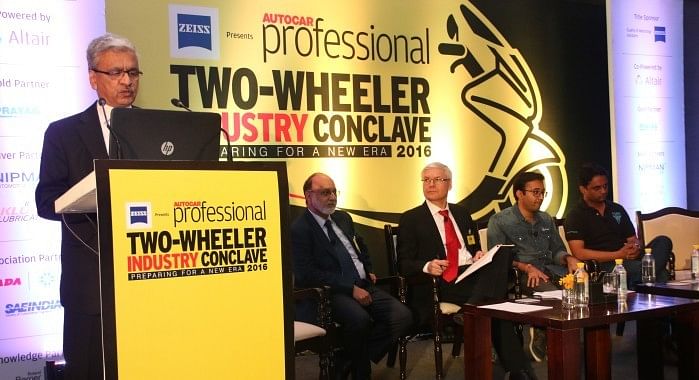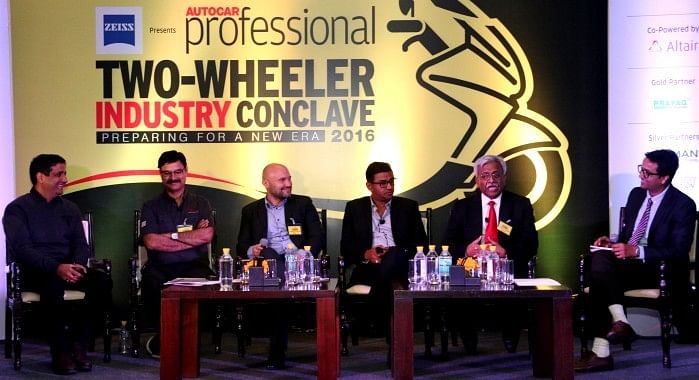BS VI, e-mobility and young buyers to reshape India's two-wheeler industry
Autocar Professional hosts the country’s first ever two-wheeler industry conclave on Wednesday which saw participation from over 175 representatives of two-wheeler OEMs, suppliers and other industry stakeholders.
Autocar Professional hosted the country’s first-ever two-wheeler industry conclave on Wednesday which saw record participation from over 175 representatives of two-wheeler OEMs, component suppliers and other industry stakeholders.
In line with the central theme of ‘Preparing for a New Era’, the conclave saw three key sessions – ‘New Era of Regulations and Technologies’, ‘A New Era of Mobility’, and ‘A New Era in the Marketplace’. Each session had eminent panelists representing the captains and think-tanks of the Indian two-wheeler industry.
With lively debates on the most imminent challenges and opportunities that lie ahead for the Indian two-wheeler industry, participants used the platform of the conclave discerningly to identify future avenues of growth and deliberated ways to overcome present and upcoming challenges.
The day’s proceedings kicked off with a video message from TVS Motor Company’s chairman and managing director Venu Srinivasan, who straightaway addressed the elephant in the room by saying that two-wheeler emissions need to be curtailed significantly, if the Indian industry needs to be at par with European standards.
“With the worsening pollution in Indian cities, we have to cut emissions significantly. We have to conform to higher standards of emissions and that can be achieved by two ways – through improving combustion and efficiency and secondly through light hybridisation. I believe that hybrids and plug-in hybrids would be a norm in India by 2020-2021,” said Srinivasan.
Session 1: New Era of Regulations and Technologies

The first session of the day began with an insightful presentation by Dr Wilfried Aulbur, managing partner India, Head – Automotive, Roland Berger, which detailed the growth opportunities and the effect of changing domestic and global dynamics on sales of two-wheelers. He spoke about the smart rise of scooter sales and how GST will drive future sales. He also highlighted the need to fast-track the preparedness for the upcoming safety and emission norms in India.
The first session on ‘Preparing for a new era of regulations and technologies’ saw a panel discussion among industry stalwarts like Vinay Harne, president, NPD, TVS Motor Co; Dr Ravi Damodaran, president – Strategy & Technology, Varroc Group; Dr Martin Pflueger, director – sales (India), AVL; and Sridhar V Pissay, vice-president, Sales and Marketing, Industrial Metrology Division, Carl Zeiss.
Moderated by Autocar Professional’s associate editor Sumantra B Barooah, the session saw the panelists unanimously identify the upcoming BS VI norms as both the biggest challenge and an opportunity for the Indian two-wheeler industry.
According to Harne, among the challenges emerging from the new norms, the biggest for OEMs is to keep costs under check till 2020, while bringing down emissions through the use of frugal technologies. He also highlighted the fact that a price rise of around 10% is likely to happen when the new emission norms come into place from 2020.
The Varroc Group Dr Damodaran put forth statistics showing that in order to meet BS VI two-wheeler OEMs need to cut emissions by 90% from the current levels and that it will not be easy. He also said that OEMs which continue to invest in new technologies are likely to have an edge in the changing domestic landscape and that it could bode well for them in terms of sales going forward. Adding that 3-4 years is too short a time to leapfrog from BS IV to BS VI, he said Tier 1 suppliers will have to invest around Rs 3,500 crore
AVL India’s Dr Pfluger explained how the industry will see a shift from carburetted engines to fuel injected ones in the near future to meet the upcoming stringent norms and how maintaining a balance between fuel economy and emissions could be a tough task for OEMs.
Meanwhile, Carl Zeiss’ Pissay highlighted the need for OEMs to adopt technologies like simulation in order to cut product development cycles and costs, as they already are running against a tight deadline as it is.
Overall, the session yielded strong interest from the audience as well, which utilised the Q&A round to touch upon technical aspects of cutting emissions through the use of new technologies such as a three-way catalytic convertor and particulate filter traps on two-wheelers.
Session 2: A New Era of Mobility – Building the EV Industry in India

The afternoon session, which was moderated by Roland Berger’s Dr Wilfried Aulbur, began with the engaging topic of electric vehicles and how they can make a difference. If the National Electric Mobility Mission Plan (NEMMP) 2020 is to achieve its ambitious targets, about a million high-performance electric two-wheelers are required on Indian roads.
“At the present rate of growth, we are heading for a 90 percent shortfall in NEMMP targets,” revealed Sohinder Gill CEO, Hero Electric and director - Corporate Affairs of the Society of Electric Vehicle Manufacturers (SMEV).
While the Faster Adoption and Manufacturing of hybrid and electric vehicles (FAME) scheme rolled out by the Central government last April claims that 163,921 electric two-wheelers were sold in the country in 2015-16 with 317,437 units to be sold in 2016-17, SMEV maintains that electric two-wheeler sales stood at 20,000 units in FY’16 and is pegged at 25,000 units in FY’17. FAME estimates these vehicles to touch the magical 25 million mark by 2019-20 while SMEV pegs them at 250,000 units growing at a CAGR of about 8 percent till FY’20.
Hence, there is an urgent need to step up the production and sale of electric two-wheelers. The NEMMP in turn that was launched in 2013 targets 6-7 million electric and hybrid vehicles by 2020 with some level of indigenisation. SMEV is forecasting a shortfall by the completion of the plan period. This despite electric two-wheelers being non-polluting and accruing in a saving of 70 paise per km compared to petrol two-wheelers that cost roughly Rs 1.20 per km in terms of fuel consumption. A major constraint though in using electrics is the high cost of lithium ion batteries that steps up the cost of the EV.
“We need to incentivise the use of lithium ion batteries,” said Gill. The FAME scheme offers incentives to consumers for the purchase of electric and hybrid vehicles.
But the lithium ion battery along with critical components like the e-motor, controller continues to be imported from countries like China, Korea and Taiwan and even the US that raises the price of the xEVs. Hence, local production of lithium ion batteries is imperative to tap economies of scale.
In addition, Gill suggested that two-wheeler fleets used in the delivery chain should be fully converted to electrics over the next two years as they are currently running on BS-II emission norms and are very polluting being petrol driven.
At the current rate of growth, catching up with the China growth story is out of reach. Citing statistics, Gill said around 25 million electric two-wheelers were sold in 2015 that too with no significant subsidies being offered. He added that the Chinese e-bike market has moved from 250W to 500W products. He said if India’s EV programme has to succeed, it should adopt a combination of China’s ‘nudging’ to consumers and offering incentives to e-bike buyers in India
Two start-ups participating at the event were Ather Energy of Bangalore and Tork Motorcycles. While agreeing that charging infrastructure is inadequate for EVs currently, Tarun Mehta, co-founder and CEO, Ather Energy, confirmed that the start-up that has developed its first smart electric scooter Ather S340, plans to provide charging infrastructure in Pune, Bangalore and Chennai leveraging its vendor eco-system to boost EV sales.
“The way forward is electric and connected for which there is no better time than now to start work. Initiatives like make in India, smart cities, EV subsidies and clean environment will drive this growth forward,” Mehta added.
For this long-term investments would be necessitated to be made on developing new platforms and new vendors, setting up of distribution and servicing centres, energy infrastructure and facilitating vertical integration to make the EV cost effective. On the other hand Kapil Shelke, director, Tork Motorcycles, the company that has just launched its first fastest electric motorcycle with a 100km-plus range, maintains that everything revolves around owning a brand. Pre-sales and post sales are always the customer pain points, according to him.
In his presentation, PS Ashok, senior VP and Head (R&D and Pune Operations), Mahindra Two Wheelers, spoke on global trends in e-mobility. While Norway sees 23% of all vehicles sold being EVs, Germany is leading in Europe with an 82% increase in EV sales volumes in 2015. Also, the fact that Tesla has reached a production volume of over 8,000 cars a month. He said the future in developed markets will see some countries make moves to ban all non-EVs and allocating recharging facilities in new residential and commercial buildings.
Pointing the way forward in India, he said there is a need for a compulsory shift to EVs to achieve critical volumes as also governmental support and incentives for technology transfer and local manufacture of batteries and motors. While OEMs need to focus on optimisation of battery consumption through software and controller, Tier 1 suppliers have to drive localisation of EV components like battery, motor and controller as also attempt tech innovation for fast charging.
Session 3: A new era in the marketplace

This session was all about the changing dynamics characterised by the rise of new segments (sweet spots), market demand, supply and investments, new retail avenues – all tapping the new and aspirational young India.
The speakers who participated with much enthusiasm and thought-provoking insights were Pankaj Dubey, MD, Polaris India; Vimal Sumbly, MD, Triumph Motorcycles India; Roy Kurian, VP – marketing & sales, Yamaha Motor India Sales; Malo Le Masson, Head – global product planning, Hero MotoCorp and Nikunj Sanghi, director – international affairs and global relations, Federation of Automobile Dealers Association (FADA).
The Indian two-wheeler industry currently sees over 15 prominent players, of which only seven have been operating in the rapidly growing scooter market. The scooter market, which stood at a size of fewer than three million units in FY2012-13, crossed the five-million-unit milestone for the first time ever in FY2015-16. The last fiscal marked a YoY growth of 31 percent, clearly highlighting how the scooters are making inroads and changing the landscape of the motorcycle-dominated market.
All panelists unanimously agreed that increasing urbanisation, female buyers across big and small cities, convenience of riding via automatic transmission systems (CVTs) and practical utility in scooters are major factors contributing to their growth. That said, the panel discussion, which was moderated by Autocar Professional’s assistant editor Amit Panday, also highlighted a few sweet spots that have emerged within the scooter segment including various sub-segments.
While Dubey of Polaris highlighted that scooters, premium motorcycles and two-wheelers with alternate fuel technologies will grow and evolve in the future, Kurian of Yamaha pointed out that, given the current growth rate, the two-wheeler industry could touch 24 million units by 2020.
Although it is understood that the 110cc scooter segment is the most popular class, industry representatives foresee that 125cc and 150cc categories will evolve over time, thanks to the advancements in technologies and features.
“Moto-scooter, generally referred to as hybrids between a motorcycle and a scooter, will also see evolution in the coming years,” commented Dubey of Polaris India.
Masson of Hero MotoCorp gave his impressions of the potential opportunities across the scooter and motorcycle segments. “India is likely to see a big jump in volumes in the Rs 200,000–500,000 price segment over the next two to three years. The two-wheelers that are increasingly being manufactured in India are also more relevant for the global markets,” he added.
Masson sees move to upgrade to BSVI emission norms as a global export opportunity for the Indian two-wheeler industry.
Sumbly of Triumph Motorcycles India remarked on the staggering growth registered by the 500cc and above motorcycle segment(s). Leading in emerging categories such as retro-classic and adventure-touring motorcycles, Triumph Motorcycles India has contributed substantially in expanding the premium motorcycle market in India.
“Customers are looking for premium experience and they want it early in their lives. The premium motorcycles are in-line with the aspirational values of the young generation, which is increasingly turning up at the retail showrooms to get the touch-and-feel of these premium products. Secondly, there are approximately 9 percent of all female buyers who are saving up to buy premium motorcycles,” he stated.
Representing the dealer community, Sanghi commented on many aspects including shifts in retail experiences, digitisation and future challenges. He foresees the potential of the emergence of retail via online platforms such as Paytm, Snapdeal, Flipkart and others.
“I believe that everybody is aware of the basic commuting experience today. A 100cc motorcycle is perceived to be a reliable and cost-effective mode of commuting. I think retail of small-capacity two-wheelers will pick up on the online platforms in the coming future. It has already started as Hero MotoCorp, the largest manufacturer, is selling its models via Snapdeal, which seconds this emerging trend,” remarked Sanghi.
All in all, the conclave proved to be a day of exciting two-wheeler industry-specific content. Attended by around 175 business visitors representing OEMs, component suppliers and industry stakeholders, it is amply clear that industry executives are actively engaged in chalking out new strategies across the manufacturing, technology and marketing verticals to address the two-wheeled industry of tomorrow.
RELATED ARTICLES
JSW MG Motor India confident of selling 1,000 M9 electric MPVs in first year
The 5.2-metre-long, seven-seater luxury electric MPV, which will be locally assembled at the Halol plant in Gujarat, wil...
Modern Automotives targets 25% CAGR in forged components by FY2031, diversifies into e-3Ws
The Tier-1 component supplier of forged components such as connecting rods, crankshafts, tie-rods, and fork bridges to l...
VinFast’s second plant in Vietnam goes on stream ahead of India factory
Vietnamese EV maker’s second plant in its home market, which has a 200,000 EVs-per-annum capacity, will focus on produci...





 By Autocar Professional Bureau
By Autocar Professional Bureau
 17 Nov 2016
17 Nov 2016
 12094 Views
12094 Views
































